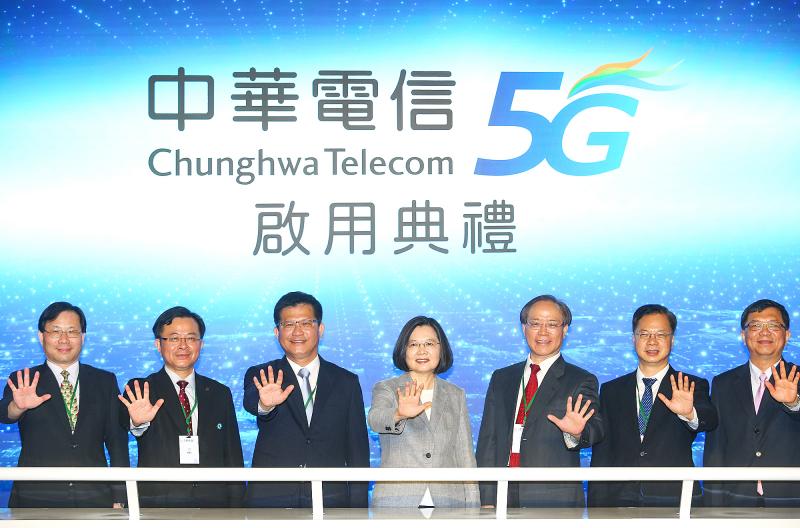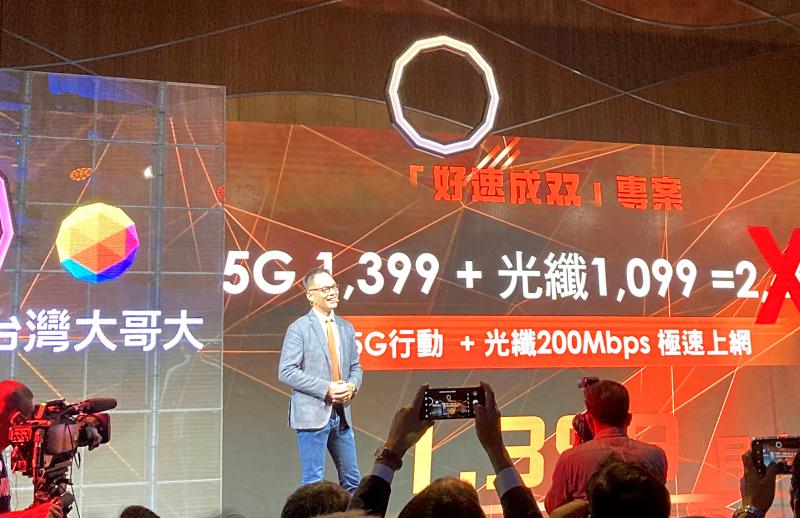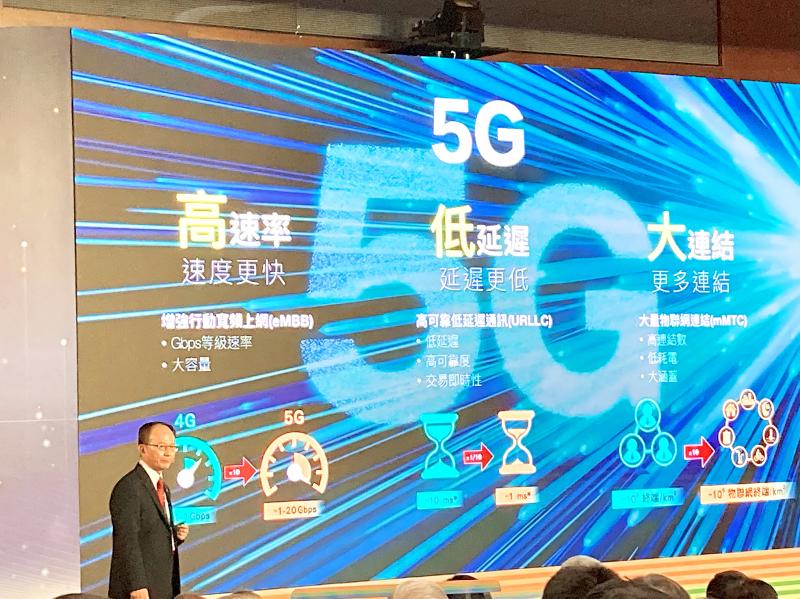Chunghwa Telecom Co (中華電信) yesterday became the nation’s first telecom to debut its 5G services, offering tiered tariffs that include a threshold of NT$599 and flat rates, as it aims to switch half of its subscribers to the 5G network within three years.
Subscribers would have unlimited data transmission for monthly fees starting at NT$1,399 — the same flat rate as when the company launched its 4G service in 2014 — and they can subscribe to the highest-rate plan for NT$2,699 per month for faster data transmission speeds and larger bandwidth, the company said.
Data transmission speeds would be within the range of 500 megabytes per second to 1.5 gigabytes per second, the company said.

Photo: CNA
Hotspot sharing volume would be limited to 50 gigabytes, it said.
“To some extent, a flat rate is a requirement in Taiwan’s market. However, the tariffs are very, very low, compared with those offered in South Korea or Japan,” Chunghwa Telecom chairman Sheih Chi-mau (謝繼茂) told reporters on the sidelines of the launch event.
South Korea’s KT Corp charges fees equivalent to at least NT$2,040 per month and SK Telecom Co offers a monthly rate of NT$2,400 for unlimited data transmission, according to information provided by Chunghwa Telecom.

Photo: Lisa Wang, Taipei Times
The company expects half of its 10.5 million mobile subscribers to switch to the 5G network within three years, Sheih said.
The company expects to reach 1 million 5G subscribers in the first year of commercial launch, he said.
However, the company said 5G would not be a panacea for a persistent decline in telecom revenue.

Photo: Lisa Wang, Taipei Times
“It will be good enough to see a flat 5G telecom revenue,” Sheih said, responding to a reporter’s question about whether 5G would provide an opportunity for the company to reverse a revenue downtrend.
Chunghwa Telecom plans to double the number of its 5G base stations to 4,000 by the end of this year, compared with 2,000 now, he said.
The number would climb to more than 10,000 by 2022, he added.
The company plans to invest NT$27 billion (US$910.32 million) on its network infrastructure.
Separately yesterday, Taiwan Mobile Co (台灣大哥大) said that it would launch 5G services today.
It also aims to boost the 5G penetration rate among its subscribers to 50 percent within three years, company president Jamie Lin (林之晨) told reporters at a news conference in Taipei.
During the period, Taiwan Mobile is targeting expanding its 5G network by deploying more than 10,000 base stations to cover 90 percent of the nation’s population, Lin said.
With new 5G services on offer, such as instant playback for sports and virtual reality video streaming, the company expects non-telecom services to contribute NT$100 billion to its revenue over the period.
Taiwan Mobile also plans to offer tailor-made 5G rate plans for mobile game players later this year, Lin said.
Taiwan Mobile’s rate plans are similar to those of Chunghwa Telecom, with additional free high-speed broadband connection.
Far EasTone Telecommunications Co (遠傳電信) is to launch its 5G services on Friday.

Nvidia Corp chief executive officer Jensen Huang (黃仁勳) on Monday introduced the company’s latest supercomputer platform, featuring six new chips made by Taiwan Semiconductor Manufacturing Co (TSMC, 台積電), saying that it is now “in full production.” “If Vera Rubin is going to be in time for this year, it must be in production by now, and so, today I can tell you that Vera Rubin is in full production,” Huang said during his keynote speech at CES in Las Vegas. The rollout of six concurrent chips for Vera Rubin — the company’s next-generation artificial intelligence (AI) computing platform — marks a strategic

Shares in Taiwan closed at a new high yesterday, the first trading day of the new year, as contract chipmaker Taiwan Semiconductor Manufacturing Co (TSMC, 台積電) continued to break records amid an artificial intelligence (AI) boom, dealers said. The TAIEX closed up 386.21 points, or 1.33 percent, at 29,349.81, with turnover totaling NT$648.844 billion (US$20.65 billion). “Judging from a stronger Taiwan dollar against the US dollar, I think foreign institutional investors returned from the holidays and brought funds into the local market,” Concord Securities Co (康和證券) analyst Kerry Huang (黃志祺) said. “Foreign investors just rebuilt their positions with TSMC as their top target,

REVENUE PERFORMANCE: Cloud and network products, and electronic components saw strong increases, while smart consumer electronics and computing products fell Hon Hai Precision Industry Co (鴻海精密) yesterday posted 26.51 percent quarterly growth in revenue for last quarter to NT$2.6 trillion (US$82.44 billion), the strongest on record for the period and above expectations, but the company forecast a slight revenue dip this quarter due to seasonal factors. On an annual basis, revenue last quarter grew 22.07 percent, the company said. Analysts on average estimated about NT$2.4 trillion increase. Hon Hai, which assembles servers for Nvidia Corp and iPhones for Apple Inc, is expanding its capacity in the US, adding artificial intelligence (AI) server production in Wisconsin and Texas, where it operates established campuses. This

US President Donald Trump on Friday blocked US photonics firm HieFo Corp’s US$3 million acquisition of assets in New Jersey-based aerospace and defense specialist Emcore Corp, citing national security and China-related concerns. In an order released by the White House, Trump said HieFo was “controlled by a citizen of the People’s Republic of China” and that its 2024 acquisition of Emcore’s businesses led the US president to believe that it might “take action that threatens to impair the national security of the United States.” The order did not name the person or detail Trump’s concerns. “The Transaction is hereby prohibited,”